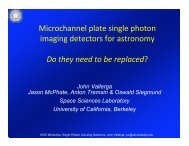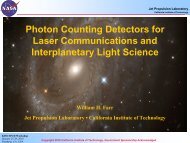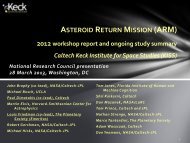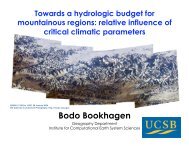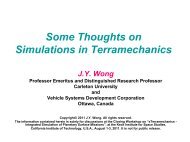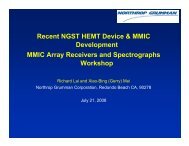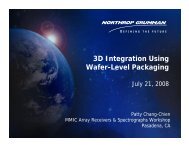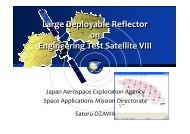Target NEO: Open Global Community NEO Workshop Report
Target NEO: Open Global Community NEO Workshop Report
Target NEO: Open Global Community NEO Workshop Report
You also want an ePaper? Increase the reach of your titles
YUMPU automatically turns print PDFs into web optimized ePapers that Google loves.
DRAFT: RELEASED FOR PUBLIC COMMENTregard; the range of total mission ∆v, duration, and Earth departure season offered by known <strong>NEO</strong>sand how that maps to mission mass requirements; how our current understanding of astrodynamic<strong>NEO</strong> accessibility is related to <strong>NEO</strong> detection and observation constraints; and launch architectureconsiderations, particularly with regard to the consequences of relying on multiple launches toperform an HSF mission to a <strong>NEO</strong>. The basic profile of a round-trip mission to a <strong>NEO</strong> is shownin Figure 1, with major maneuvers and segment flight times labeled and described.Figure 1: Profile of a Round-Trip HSF Mission to a <strong>NEO</strong>Several independent studies have been conducted throughout the past couple of years to analyzethe known <strong>NEO</strong> population in search of those which may be accessible for HSF missions, withparticular emphasis on identifying <strong>NEO</strong>s that offer low ∆v, short-duration mission opportunitieswith Earth departure dates between 2025 and 2030 [1, 2, 3]. Some studies have also exploredthe utilization of solar electric propulsion for missions to <strong>NEO</strong>s [4] and other destinations beyondLEO [5]. In September of 2010, NASA began a <strong>NEO</strong> accessibility survey effort known as the NearEarth Object (<strong>NEO</strong>) Human Space Flight (HSF) Accessible <strong>Target</strong>s Study (NHATS). Phase I ofthe NHATS was completed by the end of September 2010, and Phase II was completed by thebeginning of March 2011. The entire known <strong>NEO</strong> population at the time was processed in both thePhase I and Phase II studies, though the trajectory processing parameters were revised for PhaseII. Subsequent phases of the NHATS may be conducted as additional <strong>NEO</strong>s are discovered.DRAFT: RELEASED FOR PUBLIC COMMENT 5




